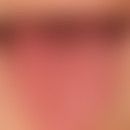Synonym(s)
AT Deficiency; Keratosis palmoplantaris circumscripta seu areata; Keratosis palmoplantaris with corneal dystrophy; oculocutaneous; Oculocutaneous Tyrosinemia; OMIM 276600; Oregon type tyrosinamia, tyrosinosis; Richner-Hanhart Syndrome; Richner urinary hard syndromes; Tyrosine aminotransferase deficiency; Tyrosinemia oculocutaneous; Tyrosinemia type 2; Tyrosinemia type II; TYRSN2
HistoryThis section has been translated automatically.
Richner, 1938; Hanhart, 1947
DefinitionThis section has been translated automatically.
Hereditary defect of tyrosine aminotransferase with increased tyrosine level in the blood, punctiform to band-like, clavus-like palmoplantar keratosis, subungual keratoses in combination with corneal dystrophies, mental retardation, short stature; possibly multiple lipomas, lingua plicata, intestinal and bladder diverticulosis.
You might also be interested in
EtiopathogenesisThis section has been translated automatically.
Autosomal recessive mutations of the TAT gene (tyrosine aminotransferase gene; gene locus: 16q22.1-q22.3) with consecutive deficiency of tyrosine aminotransferase and elevated tyrosine levels in the blood.
ManifestationThis section has been translated automatically.
Skin and eye changes often manifest themselves in childhood. Neurological disorders occur later.
LocalizationThis section has been translated automatically.
Especially finger and toe tips, Palmae, Plantae.
LaboratoryThis section has been translated automatically.
Tyrosinemia, tyrosinuria.
TherapyThis section has been translated automatically.
Low tyrosine and phenylalanine diet. Including significant improvement of symptoms. If necessary, excision of painful corneal plates, keratoplasty (little success in the plantae area, good results in the palmae area).
Progression/forecastThis section has been translated automatically.
Partly spontaneous healing of the Palmae. No improvement of the plantae.
LiteratureThis section has been translated automatically.
- Aydin OF et al (2003) Two siblings with tyrosinaemia type 2 Eur J Pediatr 162: 81-83
- Hanhart E (1947) New special forms of keratosis palmo-plantaris among others a regular dominant form with systematized lipomas, furthermore two simple recessive forms with feeble-mindedness and e.g. with corneal alteration of the eye (ectodermal syndrome). Dermatologica 94: 286-308
- Natt E et al (1987) Inherited and de novo deletion of the tyrosine aminotransferase gene locus at 16q22.3 in a patient with tyrosinemia type II. Hum Genet 77: 352-358
- Richner H (1938) Corneal affection in Keratoma palmare et planttare hereditarium. Clin Monatsbl Ophthalmology 100: 580-588
- Salamon T et al (1988) Four cases of Richner-Hanhart syndrome (tyrosinemia type II) with neurological symptomatology in a Yugoslav family. Dermatologist 39: 149-154
Incoming links (4)
Eye diseases, skin changes; Richner-hanhart syndrome; Tyrosinemia, oculocutaneous; Tyrosinemia type ii;Disclaimer
Please ask your physician for a reliable diagnosis. This website is only meant as a reference.







